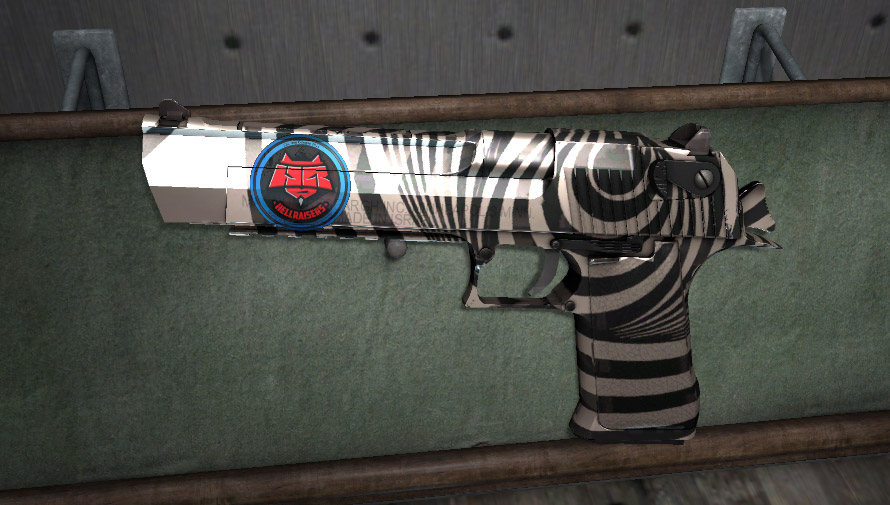What makes a good game gun?

We write about FPSes each week in Triggernometry, a mixture of tips, design criticism, and a celebration of virtual marksmanship.
There isn’t enough poetry being written about guns. Not literal limericks or sonnets (that would be creepy), but words that dig into and capture what makes one game’s AK-47 more fun than another’s.
“Weapon feel” continues to be the nebulous catch-all for the nuances that make guns fun. Most of the reviews of shooters I read offer the same praise: guns “feel great” or “feel really powerful.” If the writer’s being generous, they’ll use a word like “punchy” to describe an SMG. I’ve been guilty of this too during my six-year term at PC Gamer.
Months of work goes into designing, animating, and balancing the things that put the S in FPS, so maybe we should take a moment to talk about what makes a good gun good.
I think the visual design of weapons matters far less than we think it does. There’s a tendency, probably because they’re planted right in front of our perspective at all times, to think of guns as a collection of aesthetics: firing and reload animations, SFX, screen shake, particle effects, and the death animations they produce. Those things make a gun, right? So if those things are good, surely we have an interesting and fun video game weapon, right?
No. Consider the AWP: it’s olive green, it’s bland, and its simple animations are more run-of-the-mill than Rambo. The only aesthetically remarkable thing about the most revered, iconic, and infamous sniper rifle in a video game is that it’s a bit loud. And yet thousand-comment debates erupt when Valve tweaks the way the AWP’s scope works. Why?
A gun’s look and sound are part of its personality, sure. But if you ask me, great video game weapons have meaningful, interconnected relationships with other game elements. Those elements differ from game to game, of course. In CS’ case, the appeal of the AWP is born from the fact that CS is an FPS with body-part-specific damage modeling and no respawns. In that context, it’s the only gun that grants an instant kill if you tag someone above the waist.
That feeling of possibility is fun within the strict rules of CS’ movement: if you can hit it, you can kill it… but you also can’t be moving too much when you fire. With that power comes responsibility, too. Killed players surrender their equipped weapon in CS, and stolen AWPs not only save your team $4750 but act as a kind of trophy. This is doubly the case in CS:GO, where a player’s custom AWP skin reminds all spectators which irresponsible player allowed their AWP to fall into enemy hands. Buying an AWP, then, to some extent, announces to the rest of the server: “I think I’m a good enough shot to protect this valuable asset from the other team.”
The biggest gaming news, reviews and hardware deals
Keep up to date with the most important stories and the best deals, as picked by the PC Gamer team.
All of this makes the AWP a weapon with abundant meaning. Even its shortcomings (slow rate of fire, difficult to use in close quarters) are a source of fun: the noscope is a revered skillshot.
In Tribes’ case, its weapons shake hands with its player movement really well, arguably the quality that defines it as an FPS. Again, like the AWP, the Spinfusor isn't visually extraordinary: it fires discs at a medium speed, and its animations and SFX are pretty modest. But the Spinfusor is the perfect fit, the perfect baseline weapon in a game where your targets are typically skiing along the ground at high speed. Its splash damage leaves room for error and its relatively slow travel time creates an exciting feeling of uncertainty as you admire your shot. Like throwing up a three-pointer in basketball, you get to experience that arc of “Will it go in? It might not go in. It went in!” as the disc travels toward its target.
The Fusion Mortar creates the same sort of feeling while operating as a parabolic siege weapon. The design of the weapons actually encourages you to spend as much time as possible in the air: the threat they pose encourages you to master movement to have the best chance of staying alive. In each of these examples, the weapons strengthen the meaning and significance of core systems like movement, damage modeling, or weapon purchasing.

Evan's a hardcore FPS enthusiast who joined PC Gamer in 2008. After an era spent publishing reviews, news, and cover features, he now oversees editorial operations for PC Gamer worldwide, including setting policy, training, and editing stories written by the wider team. His most-played FPSes are CS:GO, Team Fortress 2, Team Fortress Classic, Rainbow Six Siege, and Arma 2. His first multiplayer FPS was Quake 2, played on serial LAN in his uncle's basement, the ideal conditions for instilling a lifelong fondness for fragging. Evan also leads production of the PC Gaming Show, the annual E3 showcase event dedicated to PC gaming.

